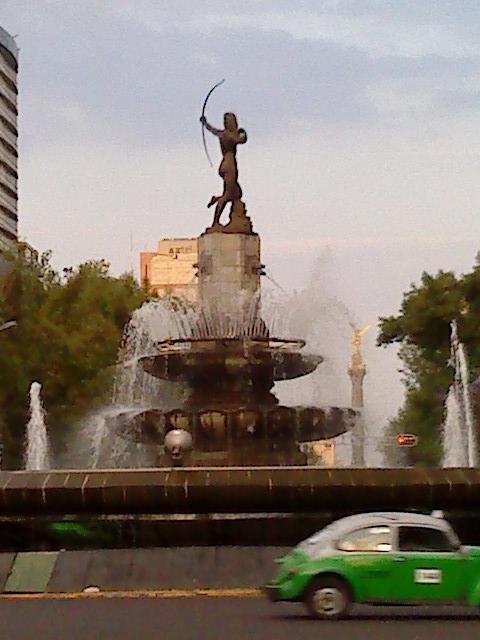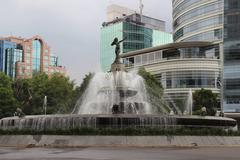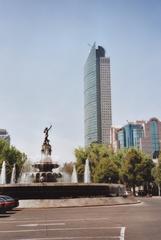
Diana The Huntress Fountain: Visiting Hours, Tickets, and Complete Guide for Mexico City
Date: 15/06/2025
Introduction: History and Cultural Significance
The Diana The Huntress Fountain (Fuente de la Diana Cazadora) stands as an enduring symbol of Mexico City’s fusion of tradition, progress, and artistic innovation. Located prominently on the renowned Paseo de la Reforma, this iconic bronze sculpture has been captivating visitors and locals alike since its unveiling in 1942. Conceived during a period of ambitious modernization under President Manuel Ávila Camacho, the fountain was designed by architect Vicente Mendiola and sculptor Juan Fernando Olaguíbel. Their vision was to create a monument that not only beautified the city but also reflected its evolving identity and aspirations (Mexico City Tourism).
The fountain’s forward-reaching depiction of Diana, the Roman goddess of the hunt, embodies strength, ambition, and the pursuit of progress. This modern, dynamic representation broke with the conservative artistic norms of the era and became a focal point of both admiration and controversy. The model for Diana, Helvia Martínez Verdayes, was only 16 when she posed for the sculpture, and her participation remained shrouded in secrecy for years due to the public reaction to the statue’s nudity (Smithsonian Magazine).
Today, the Diana The Huntress Fountain is not only a beloved work of public art but also an emblem of Mexico City’s cultural resilience, social evolution, and civic pride. This guide offers a detailed look at its history, design, public reception, and all the essential visitor information—covering hours, accessibility, nearby attractions, and practical travel tips.
Table of Contents
- Historical Overview and Artistic Origins
- The Model: Helvia Martínez Verdayes
- Design, Symbolism, and Controversy
- Restoration and Legacy
- Visiting Hours, Tickets, and Accessibility
- Travel Tips and Safety
- Nearby Attractions and Amenities
- Frequently Asked Questions (FAQ)
- References
Historical Overview and Artistic Origins
Commissioned at the height of Mexico City’s 1940s modernization, the fountain was envisioned to enhance the European-inspired Paseo de la Reforma. Architect Vicente Mendiola and sculptor Juan Fernando Olaguíbel brought Diana to life atop a circular fountain, her body captured in a pose of tension and grace, aiming her arrow skyward.
Located at a major roundabout near Chapultepec Park, this monument was meant to be accessible and visible, standing as a testament to the city’s urban ambitions (Mexico City Tourism).
The Model: Helvia Martínez Verdayes
The statue’s model, Helvia Martínez Verdayes, was a young secretary who hesitated to pose for the sculpture. Ultimately, she was convinced by Olaguíbel’s promise of artistic immortality and the offer of a simple treat—ice cream. Due to the public uproar over Diana’s nudity, her identity was kept secret for decades (Smithsonian Magazine).
Design, Symbolism, and Controversy
Olaguíbel’s sculpture is a striking example of Art Deco influence in Mexican public art, characterized by sharp lines and dynamic movement. Diana’s nudity and forward stance signaled a shift from passive artistic representations of women to one of agency and power. This boldness, however, sparked protests from conservative sectors and led to the temporary addition of a bronze loincloth, altering the original vision (Mexico City Official Tourism).
The controversy eventually subsided, and ahead of the 1968 Olympics, the loincloth was removed, though the process damaged the statue. The original was subsequently relocated to Olaguíbel’s hometown, and a faithful replica was installed in 1992.
Restoration and Legacy
The Diana The Huntress Fountain has been meticulously restored and remains one of the city’s most recognizable landmarks. Its influence has spread; replicas exist in other Mexican cities, and the fountain continues to appear in popular culture, literature, and art, reinforcing its place in the nation’s collective memory (Mexico Historico).
Visiting Hours, Tickets, and Accessibility
- Location: Paseo de la Reforma, at the intersection with Río Rhin Avenue, Zona Rosa & Reforma district (Lonely Planet).
- Hours: The fountain is accessible 24 hours a day, 7 days a week.
- Tickets: No entrance fee; it is a free public monument.
- Accessibility: The sidewalks around the fountain are wide and suitable for wheelchairs. However, due to its placement in a traffic circle, visitors should view the monument safely from sidewalks or nearby terraces. Metro stations Sevilla and Insurgentes are nearby, and several bus lines and EcoBici bike-sharing stations serve the area (The Unconventional Route).
Travel Tips and Safety
- Best Time to Visit: Early mornings and late afternoons for optimal lighting and fewer crowds. Spring (March–May) offers mild temperatures and blooming jacaranda trees (Travellers Worldwide).
- Photography: The fountain is especially photogenic at sunrise, sunset, and when illuminated at night. For panoramic views, consider rooftop bars or terraces nearby (reservations may be required).
- Safety: Zona Rosa & Reforma is generally safe during the day. At night, stay in well-lit, populated areas and avoid crossing traffic lanes outside designated crossings.
- Weather: Bring a jacket or umbrella during rainy season (June–August), and use sunscreen year-round.
Nearby Attractions and Amenities
- El Ángel de la Independencia: Iconic independence monument, just a short walk away (Lonely Planet).
- Museo de Arte Moderno: Modern art museum featuring works by famed Mexican artists.
- Chapultepec Park: Expansive green space that includes museums, a zoo, and lakes.
- Centro de Cultura Digital: Digital culture and arts hub nearby.
- Dining and Shopping: Zona Rosa offers a vibrant array of restaurants, cafés, shops, and nightlife options.
Frequently Asked Questions (FAQ)
Q: Is there an entrance fee to visit Diana The Huntress Fountain?
A: No. The fountain is a public monument and free to visit at all times.
Q: What is the best way to get there?
A: The fountain is accessible by Metro (Sevilla station, Line 1), bus, and EcoBici. Taxis and ride-shares are also available.
Q: Is the fountain wheelchair accessible?
A: The surrounding sidewalks are accessible, though direct access to the fountain is limited due to its location in a roundabout.
Q: Are guided tours available?
A: Many walking and bike tours of Paseo de la Reforma and Zona Rosa include the fountain and provide historical context.
Q: Can I visit at night?
A: Yes, the fountain is illuminated after dark and can be safely viewed from the sidewalks.
Practical Visitor Tips
- Hydration: Mexico City’s high altitude can cause dehydration. Carry a reusable water bottle.
- Respect the Monument: Do not climb or damage the statue or its surroundings.
- Combine Visits: Consider pairing your visit with other nearby landmarks for a fuller experience.
- Special Events: On weekends and during festivals, Paseo de la Reforma may be closed to vehicles, allowing safe pedestrian access near the fountain.
Summary
The Diana The Huntress Fountain is a must-see for those seeking to experience Mexico City’s unique blend of historical tradition and modern vitality. With its compelling backstory, artistic boldness, and prime location amidst the city’s premier attractions, it promises a memorable visit. Whether you’re an art enthusiast, a history buff, or simply exploring the city, this monument offers a rich window into the heart of Mexico’s capital.
References
- Mexico City Tourism
- Smithsonian Magazine
- Mexico City Official Tourism
- Mexico Historico
- Lonely Planet
- The Unconventional Route
- Travellers Worldwide












































































































































































